Abstract
NiO-based hole-transport layers are crucial for high-efficiency perovskite solar cells. An industrial deposition method of NiO films is magnetron sputtering using ceramic targets. NiO targets doped with Li contents at 1%, 3%, and 5% were designed, and the doping contents and sintering temperatures were investigated. All the targets have a face-centered cubic phase, dense microstructure, and an average size of a few microns. The NLO targets sintered at an optimal temperature of 1400 °C exhibited high relative density (>98%) and low resistivity (<6 Ω∙cm). These results pave the way for depositing NiO-based hole-transport layer by magnetron sputtering.
1. Introduction
Solar energy, boasting the merits of being clean and safe, possessing substantial capacity, and being widely distributed, presents a feasible solution to the energy crisis. Perovskite solar cells (PSCs) have a significant competitive advantage in the photovoltaic market because of its low-cost, high efficiency, and easy preparation [,]. A transparent oxide semiconductor (TOS) layer is a thin film with high transmittance in the visible region and adjustable resistivity, which is widely used in devices, such as flat panel displays, solar cells, and light-emitting diodes [,,,,]. Nickel oxide (NiO) is one of the candidates for p-type TOS films due to its wide bandgap (3.6~4.0 eV), high chemical stability, and excellent optoelectronic properties [,]. NiO films as hole-transporting layers (HTLs) in PSCs have the advantages of having low-processing temperatures and a negligible J-V hysteresis effect, illustrating better long-term stability [,].
In order to further improve the performance of PSCs, one area of study is the fabrication of NiO HTLs. NiO films fabricated by the low-temperature spray combustion method showed a uniform and dense structure, contributing to achieving a high efficiency of 12.7% for PSCs []. The NiO films with better crystallinity were prepared by magnetron sputtering at 300 °C, having the highest efficiency of up to 14.11% []. The mesoporous NiOx films fabricated by the electrochemical deposition method achieved an optimal power conversion efficiency of 17.77% []. NiO film was prepared by electron beam evaporation at room temperature, resulting in a champion device efficiency of 17.82% []. A highly transparent NiO layer prepared by the solution processing method had an excellent light transmittance and matching energy level, resulting in a power conversion efficiency of 18.15% []. There are various methods for preparing NiO films, among which magnetron sputtering is considered suitable for industrial production because of its advantages of having a high deposition rate, good film density, and uniformity [,]. The ceramic targets emerge as a key material when NiO-based films are deposited by magnetron sputtering.
A high-density target is very important for controlling nodules during sputtering, and only a conductive target can meet the demand of direct current sputtering []. The preparation process of NiO-based ceramics has been described by different methods. The LiF-doped NiO ceramics with the additives of B2O3 and SiO2 prepared by a wet-chemical synthesis show good negative temperature coefficient (NTC) properties, and its grains were evenly distributed, but pores were formed in ceramics during the sintering process []. NiO ceramics modified by Y2O3 and BiSbO3 for thermistor application showed a significant presence of small pores, while the addition of Y2O3 elevated the sintering density to 98% []. The resistivity of the Na-doped NiO ceramics fabricated by atmospheric pressure sintering decreased with the increase in Na content, and the optimal resistivity of NiO: Na ceramics was 290 Ω·cm []. However, NiO-based ceramic targets have not been sufficiently investigated.
The conductivity modification of NiO films can be achieved by deoxidation and doping []. The pure NiO and Cu-doped NiO films, fabricated via magnetron sputtering at different oxygen partial pressures, exhibited p-type conductivity, with resistivity decreasing from 62.24 Ω·cm to 9.94 Ω·cm []. The Li-doped NiO films synthesized by spray pyrolysis obtained the best p-type resistivity of 4.1 × 10−1 Ω·cm and an optical transparency of more than 76% in the visible region []. Transparent and conductive NiO/Ag/NiO electrodes with excellent electrochromic and supercapacitive properties were fabricated at room temperature by electron beam deposition, illustrating an average transmittance of more than 70% in the visible region and extraordinarily low square resistance of only 8.0 Ω·sq−1 []. The Ni0.96Li0.04O films were prepared by RF magnetron sputtering as electrodes for Li-ion batteries, which enhances the conductivity and Li-ion storage capacity of pure NiO films [].
In this work, the Li2O was used as both dopants and sintering aids for the NiO ceramic target. The effect of Li2O doping contents on the microstructural and electrical properties of the NiO targets was investigated. The Li2O dopants can effectively improve the density and conductivity of the NiO targets, which is helpful for the application of the NiO targets in PSCs.
2. Materials and Methods
The 1%, 3%, and 5% Li2O-doped NiO ceramic targets were named as 991, 973, and 955 NLO targets, respectively. The NiO (99.95%, Nanjing Kailinstone Chemical Technology Co., Ltd., Nanjing, Jiangsu province, China) and Li2O (99.95%, Nanjing Kailinstone Chemical Technology Co., Ltd., Nanjing, Jiangsu province, China) powders were determined by their atomic weight, and the total weight was 20 g. The powders were milled in a tank for 24 h by zirconia balls. The anhydrous ethanol (45 wt%) and dispersant (3 wt%) were used to prevent powder agglomeration. The milled slurry was dried in a drying oven at 80 °C for 24 h. The dried mixed powders were calcinated at 400 °C for 3 h. After 8 hours of milling and 24 hours of drying, the calcined powders were sieved using a 150-mesh sieve. Polyvinyl alcohol (0.5 wt%) used as a binder was added to the sieved powders in the form of aqueous solution, after which the powders were granulated using a 80-mesh sieve. The green bodies with a diameter of 13 mm and a thickness of 2 mm were fabricated by pressing the granulated powders under 200 Mpa, resulting in a relative density of about 60%. The green bodies were first dewaxed at 600 °C for 3 h, and then sintered at 1250 °C, 1300 °C, 1350 °C, 1400 °C, and 1450 °C in air for 4 h.
X-ray diffraction (XRD, D8-Advance, Bruker) was used for phase analysis, and field emission scanning electron microscopy (FE-SEM, Tecnai-450, FEI) was used to study the surface and cross-sectional microstructure. The grain size distribution and average values of the targets were calculated using the Nano measurer software (V1.2.5). The density of targets was measured by the Archimedes method. The four-point probe (MCP-T700, Mitsubishi) was used to measure the resistivity of targets. The samples with sizes of 6 mm × 6 mm × 60 mm were prepared for three-point bending strength testing (Shimadzu, AG-X).
3. Results
Figure 1 shows the microstructure of the NiO, Li2O, and milled powders. It can be seen that the NiO and Li2O powders consist of softly agglomerated fine particles, resulting in large secondary particles []. However, the agglomerated raw powders were dispersed by ball milling. The milled powders with a Brunauer–Emmett–Teller (BET) value of 17.6 m2/g have a nanometer-scale size. Therefore, these soft agglomerated particles can be dispersed by the ball milling process, which contributes to the sintering densification of the NLO targets.

Figure 1.
Microstructure of (a) NiO powders, (b) Li2O powders, and (c) the milled powders.
Figure 2a shows the XRD patterns of the 955 NLO targets sintered at different temperatures. It can be seen that all the peaks of the NLO targets coincide with the standard peaks (PDF# 47-1049) for the face-centered cubic phase structure. There are no obvious impurity phases in the NLO targets, indicating that the Li ions have dissolved into the lattice of the NiO. The intensity of the peaks gradually increases with the increasing sintering temperature, indicating that the NLO targets have good crystallinity. As shown in Figure 2b, the impurity phases of 991 and 973 NLO targets sintered at temperatures ranging from 1250 °C to 1450 °C are invisible, which is in agreement with the results of the 955 NLO targets. Therefore, the NLO targets doped with three contents show a single-phase structure. Figure 2c indicates that the (200) peaks of the 991, 973, and 955 NLO targets sintered at 1250 °C shift toward the high angle with the increase in doping content. The reason for that occurrence is that the ionic radius of Li+ (0.59 Å) is smaller than that of Ni2+ (0.76 Å) [].

Figure 2.
The XRD patterns of (a) the 955, (b) 991, and 973 targets and (c) the 991, 973, and 955 targets sintered at 1250 °C.
Figure 3 shows the surface morphologies of the 991 NLO targets sintered at different temperatures. It can be seen that the grain size of the 991 NLO targets gradually increases with the increase in sintering temperature, and the grain boundaries are clear and visible. Moreover, small pores are observed on the surface when the targets are sintered at a low temperature, typically localized at grain boundaries. As the sintering temperature increases, the pores become invisible. Therefore, higher temperatures can promote sintering densification and eliminate pores.
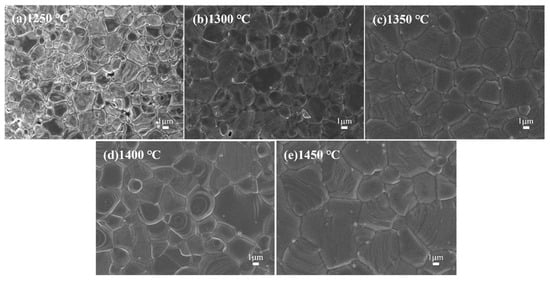
Figure 3.
The surface morphologies of the 991 targets sintered at different temperatures.
Figure 4 shows the cross-sectional morphologies of the 991 NLO targets. It can be seen that the targets have dense microstructure and small pores. The fracture propagates through the inside of the grains, illustrating the transcrystalline fracture []. In general, sputtering targets with transcrystalline fracture and fine grains have high bending strength []. The 991 NLO target used for analyzing bending strength has an average value of 98.8 MPa. Therefore, the 991 NLO targets have high bending strength, which contributes to resisting the stress effect during welding and sputtering.
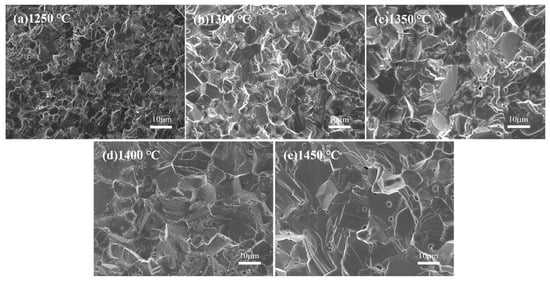
Figure 4.
The cross-sectional morphologies of the 991 targets sintered at different temperatures.
The grain size distribution of the 991 targets sintered at different temperatures is shown in Figure 5. It can be seen that the average grain size of the 991 targets gradually increases from 2.01 μm to 5.02 μm with the increase in sintering temperature, and the grains are fine and uniformly distributed.
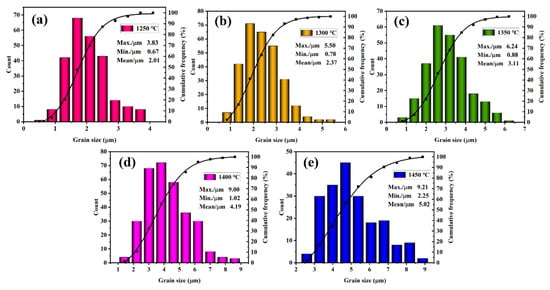
Figure 5.
The grain size distribution of the 991 targets sintered at different temperatures.
Figure 6 and Figure 7 are the surface and cross-sectional morphologies of the 973 and 955 NLO targets. It can be seen that the heavily doped NLO targets exhibit distinct grain boundaries and a denser microstructure. The Li2O additives are good sintering aids that can enhance sintering densification. The more the doping contents, the better the sintering densification. The grain size distributions in Figure 8 and Figure 9 show that the average grain size of the 973 targets increases from 3.13 μm at 1250 °C to 6.05 μm at 1450 °C, and that the average grain size of the 955 targets increases from 3.91 μm to 7.71 μm. Therefore, the Li2O additives also promote grain growth.

Figure 6.
The surface and cross-sectional morphologies of the 973 targets sintered at different temperatures.

Figure 7.
The surface and cross-sectional morphologies of the 955 targets sintered at different temperatures.
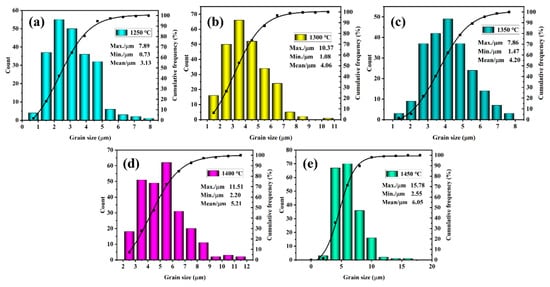
Figure 8.
The grain size distribution of the 973 targets sintered at different temperatures.
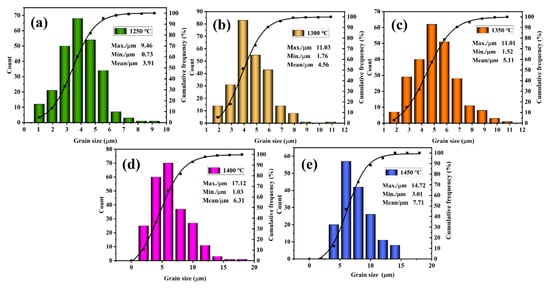
Figure 9.
The grain size distribution of the 955 targets sintered at different temperatures.
The Ni, Li, and O elemental distributions shown in Figure 10 illustrate that the Li element is uniformly distributed in the 955 NLO target, resulting in a uniform microstructure and conductivity for the NLO target. The doped oxide targets with a uniform elemental distribution and dense microstructure are significant for depositing large-sized films without defects []. The performance of the perovskite solar cells is closely related to the NiO-based films deposited by magnetron sputtering [,,].
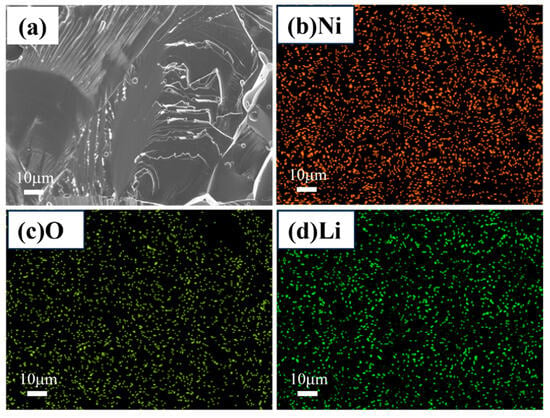
Figure 10.
(a) The cross-sectional morphology and (b) Ni, (c) O, and (d) Li element distribution in the 955 NiO target sintered at 1450 °C.
The relative density of the NiO and NLO targets sintered at different temperatures is shown in Figure 11. Figure 11a shows that the density of pure NiO target increases with increasing sintering temperature, and then decreases because of overheating. The optimal density obtained at 1450 °C is only 97.93%, which should be further improved. As shown in Figure 11b, the densities of the 991, 973, and 955 NLO targets increase markedly initially, followed by a slight decrease as the sintering temperature is further elevated. The density of 97.80% for the 991 NLO target sintered at 1250 °C is close to the optimal density of the pure NiO target obtained at 1450 °C. Therefore, Li2O can effectively decrease sintering temperature and promote sintering densification, which means it is suitable as a sintering aid for NiO-based ceramics. Compared with the density of the 991 NLO targets, the 973 and 955 NLO targets show higher density at the same sintering temperature because the high Li2O doping content is more conducive to sintering densification. The optimal densities of the 991, 973, and 955 NLO targets sintered at 1400 °C are 98.75%, 98.86%, and 99.10%, respectively. However, all the targets sintered at 1450 °C show a decreased density because Li2O sintered at 1450 °C is easy to decompose and vitalize []. Therefore, the Li2O additives decrease sintering temperature and achieve high density, which contributes to the inhibiting of nodule formation during magnetron sputtering.
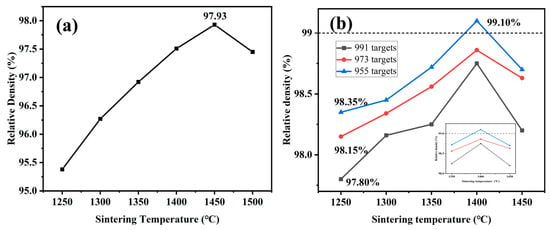
Figure 11.
The density of (a) NiO and (b) NLO targets sintered at different temperatures.
The NiO targets with high resistivity are insulating at room temperature. However, Li-doped NiO illustrates good conductivity. The resistivity of the 991, 973, and 955 targets sintered at different temperatures is shown in Figure 12. It can be seen that the resistivities of all the targets first decrease slightly and then increase as the sintering temperatures increase. The substitution of Li+ for Ni2+/3+ generates hole carriers, resulting in the formation of p-type semiconductor. The higher the doping content, the lower the resistivity. The optimal resistivities of 991, 973, and 955 NLO targets sintered at 1400 °C are 5.95 Ω∙cm, 1.27 Ω∙cm, and 0.342 Ω∙cm, respectively. However, the resistivities of all the targets sintered at 1450 °C increased slightly because of the decrease in density and the vitalization of the Li2O. Therefore, the resistivities of the NLO targets can be modified according to the conductivity requirements of NLO films for solar cells.
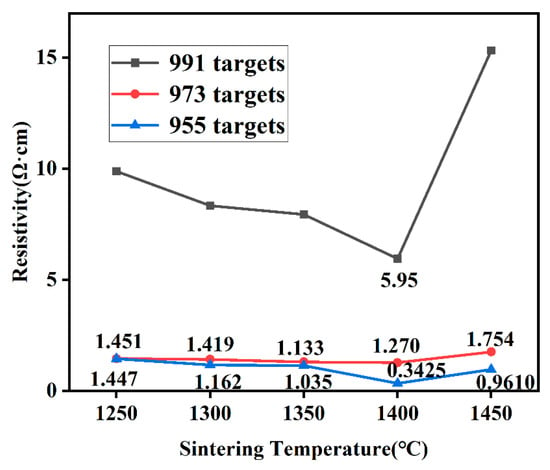
Figure 12.
The resistivity of the 991, 973, and 955 targets sintered at different temperatures.
4. Conclusions
In summary, to meet the demands of depositing the HTLs by magnetron sputtering for the PSCs, NiO targets were modified with Li2O dopants, and the doping contents and sintering temperatures were studied. All the targets had a face-centered cubic structure. With increasing sintering temperature, the microstructure became denser, and the grain size increased. The Li2O dopants promoted grain growth, and fine grains with sizes ranging from 2 μm to 6 μm were still obtained. The densities increase with the increase in doping contents, but the resistivity decreases. However, overheating results in the deterioration of density and resistivity because of Li2O decomposition and vitalization. The optimal densities of the 991, 973, and 955 NLO targets sintered at 1400 °C are 98.75%, 98.86%, 99.10%, respectively, and their corresponding resistivities are 5.95 Ω∙cm, 1.27 Ω∙cm, and 0.342 Ω∙cm. Therefore, NLO ceramic targets with high density and low resistivity can meet the demands of depositing hole-transport layer by magnetron sputtering.
Author Contributions
Conceptualization, H.X. and J.X.; methodology, J.X. and X.Z.; formal analysis, G.Z. and F.S.; investigation, J.L.; resources, H.X.; data curation, J.L. and J.X.; writing—original draft preparation, J.L.; writing—review and editing, J.X. and F.S.; supervision, H.X.; project administration, H.X.; funding acquisition, H.X. and J.X. All authors have read and agreed to the published version of the manuscript.
Funding
This work was financially supported by the Joint Fund of NSFC-Guangxi (U21A2065), the National Natural Science Foundation of China (62464004), and the Science and Technology Major Project of Guangxi (AA21077018).
Institutional Review Board Statement
Not applicable.
Informed Consent Statement
Not applicable.
Data Availability Statement
Data are contained within the article.
Conflicts of Interest
Author Xianjie Zhou was employed by the company ShenZhen APG Material Technology Co., Ltd. The authors declare that the research was conducted in the absence of any commercial or financial relationships that could be construed as a potential conflict of interest.
References
- Wang, Y.; Zhang, Z.M.; Tao, M.Q.; Lan, Y.J.; Li, M.Z.; Tian, Y.; Song, Y.L. Interfacial modification towards highly efficient and stable perovskite solar cells. Nanoscale 2020, 12, 18563–18575. [Google Scholar] [CrossRef]
- Ahmed, M.I.; Habib, A.; Javaid, S.S. Perovskite solar cells: Potentials, challenges, and opportunities. Int. J. Photoenergy 2015, 3837, 592308. [Google Scholar] [CrossRef]
- Hosono, H. Recent progress in transparent oxide semiconductors: Materials and device application. Thin Solid Films 2007, 515, 6000–6014. [Google Scholar] [CrossRef]
- Wang, K.; Vygranenko, Y.; Nathan, A. Fabrication and characterization of NiO/ZnO/ITO p-i-n heterostructure. Thin Solid Films 2008, 516, 1640–1643. [Google Scholar] [CrossRef]
- Zhang, J.Y.; Li, W.W.; Hoye, R.L.Z.; MacManus-Driscoll, J.L.; Budde, M.; Bierwagen, O.; Wang, L.; Du, Y.; Wahila, M.J.; Piper, L.F.J.; et al. Electronic and transport properties of Li-doped NiO epitaxial thin films. J. Mater. Chem. C 2018, 6, 2275–2282. [Google Scholar] [CrossRef]
- Koida, T.; Ueno, Y.; Nishinaga, J.; Higuchi, H.; Takahashi, H.; Iioka, M.; Shibata, H.; Niki, S. Cu(In,Ga)Se2 solar cells with amorphous In2O3-based front contact layers. ACS Appl. Mater. Interfaces 2017, 9, 29677–29686. [Google Scholar] [CrossRef]
- Ohta, H.; Nomura, K.; Hiramatsu, H.; Ueda, K.; Kamiya, T.; Hirano, M.; Hosono, H. Frontier of transparent oxide semiconductors. Solid-State Electron. 2003, 47, 2261–2267. [Google Scholar] [CrossRef]
- Akalin, S.A.; Erol, M.; Uzunbayir, B.; Oguzlar, S.; Yildirim, S. Sol-gel derived Li and Mg incorporated nickel oxide particles: An investigation on structural and optical properties. Opt. Mater. 2021, 118, 111223. [Google Scholar] [CrossRef]
- Singh, A.; Parida, B.; Oh, M.; Jeong, S.; Ahn, K.S.; Kim, H. Low-temperature processed nickel oxide hole-transporting layer for perovskite solar cell. J. Korean Phys. Soc. 2022, 80, 981–985. [Google Scholar] [CrossRef]
- Xu, L.; Chen, X.F.; Jin, J.J.; Liu, W.; Dong, B.; Bai, X.; Song, H.W. Inverted perovskite solar cells employing doped NiO hole transport layers: A review. Nano Energy 2019, 63, 103860. [Google Scholar] [CrossRef]
- Qin, Y.S.; Song, J.; Qiu, Q.Y.; Liu, Y.; Zhao, Y.L.; Zhu, L.; Qiang, Y.H. High-quality NiO thin film by low-temperature spray combustion method for perovskite solar cells. J. Alloys Compd. 2019, 810, 151970. [Google Scholar] [CrossRef]
- Yang, P.; Wang, J.; Zhao, X.C.; Wang, J.C.; Hu, Z.J.; Huang, Q.S.; Yang, L.J. Magnetron-sputtered nickel oxide films as hole transport layer for planar heterojunction perovskite solar cells. Appl. Phys. A 2019, 125, 481. [Google Scholar] [CrossRef]
- Wang, T.; Ding, D.; Wang, X.; Zeng, R.R.; Liu, H.; Shen, W.Z. High-performance inverted perovskite solar cells with mesoporous NiOx hole transport layer by electrochemical deposition. ACS Omega 2018, 3, 18434–18443. [Google Scholar] [CrossRef] [PubMed]
- Li, J.; Li, L.T.; Wang, S.H.; Li, R.J.; Wang, C.; Cai, J.Y.; Cheng, W.Y.; Li, J.K.; Zou, G.F.; Lu, Z. Room-temperature processed plasma activated nickel oxide film for wide-bandgap perovskite solar cells. Sol. Energy Mater. Sol. Cells 2024, 269, 112734. [Google Scholar] [CrossRef]
- Tang, L.J.; Chen, X.; Wen, T.Y.; Yang, S.; Zhao, J.J.; Qiao, H.W.; Hou, Y.; Yang, H.G. A solution-processed transparent NiO hole extraction layer for high-performance inverted perovskite solar cells. Chem. Eur. J. 2018, 24, 2845–2849. [Google Scholar] [CrossRef] [PubMed]
- Zhao, Y.; Wang, H.; Wu, C.; Shi, Z.F.; Gao, F.B.; Li, W.C.; Wu, G.G.; Zhang, B.L.; Du, G.T. Structures, electrical and optical properties of nickel oxide films by radio frequency magnetron sputtering. Vacuum 2014, 103, 14–16. [Google Scholar] [CrossRef]
- Sun, H.; Yazdi, M.A.P.; Briois, P.; Pierson, J.F.; Sanchette, F.; Billard, A. Towards delafossite structure of Cu-Cr-O thin films deposited by reactive magnetron sputtering: Influence of substrate temperature on optoelectronics properties. Vacuum 2015, 114, 101–107. [Google Scholar] [CrossRef]
- Fang, Z.J.; Tan, Z.D.; Jiang, F.; Huang, S.; Qin, J.; Wang, Y.; Han, X.H.; Li, M.Z.; Zeng, J.S. Preparation of extraordinary high-density indium-tin oxide target on the basis of pressure-less sintering method. Ceram. Int. 2024, 50, 2271–2281. [Google Scholar] [CrossRef]
- Guo, Z.Y.; Shao, J.M.; Lin, H.; Jiang, M.D.; Chen, S.Y.; Li, Z.C. Electrical conductivity & temperature sensitivity of ceramics based on NiO simple oxides for NTC applications. J. Mater. Sci. Mater. Electron. 2017, 28, 11871–11877. [Google Scholar] [CrossRef]
- Peng, D.C.; Li, Z.C.; Huang, L.L.; You, C.; Wang, H.X.; Zhang, H. Characterization of NiO based ceramics modified with Y2O3/BiSbO3 for application of NTC thermistors. J. Mater. Sci. Mater. Electron. 2022, 33, 11092–11105. [Google Scholar] [CrossRef]
- Yang, S.; Kim, J.; Song, S.; Lee, D.; Ju, T.S.; Bae, J.S.; Park, S. Role of Na-doping-induced oxygen vacancies in the variation of electrical properties of NiO ceramics. Ceram. Int. 2017, 43, 11898–11901. [Google Scholar] [CrossRef]
- Uzunbayır, B.; Akalın, S.A.; Yıldırım, S.; Erol, M.; Oğuzlar, S. Production and characterizations of Sol-Gel-derived Li, Cu: NiOx particles: An investigation on the effects of Li and Cu incorporation. J. Electron. Mater. 2023, 52, 5534–5542. [Google Scholar] [CrossRef]
- Reddy, Y.A.K.; Reddy, A.M.; Reddy, A.S.; Reddy, P.S. Structural and electrical properties of pure and Cu doped NiO films deposited at various oxygen partial pressures. AIP Conf. Proc. 2013, 1512, 640–641. [Google Scholar] [CrossRef]
- Chia-Ching, W.; Cheng-Fu, Y. Investigation of the properties of nanostructured Li-doped NiO films using the modified spray pyrolysis method. Nanoscale Res. Lett. 2013, 8, 33. [Google Scholar] [CrossRef]
- Dong, W.J.; Lv, Y.; Zhang, N.; Xiao, L.L.; Fan, Y.; Liu, X.Y. Trifunctional NiO-Ag-NiO electrodes for ITO-free electrochromic supercapacitors. J. Mater. Chem. C 2017, 5, 8408–8414. [Google Scholar] [CrossRef]
- Gao, C.Y.; Zhang, H.; Zeng, Y.; Zhang, Y.; Li, Z.C. Pre-solid-solution enhanced electrochemical performance of NiO-based thin films for Li-ion storage. J. Energy Storage 2023, 73, 109280. [Google Scholar] [CrossRef]
- Thi, T.V.; Rai, A.K.; Gim, J.; Kim, J. High performance of Co-doped NiO nanoparticle anode material for rechargeable lithium ion batteries. J. Power Sources 2015, 292, 23–30. [Google Scholar] [CrossRef]
- Liu, S.H.; Wang, J.; Jia, J.F.; Hu, X.; Liu, S.J. Synthesis and thermoelectric performance of Li-doped NiO ceramics. Ceram. Int. 2012, 38, 5023–5026. [Google Scholar] [CrossRef]
- Mercan, A.; Kara, E.; Dogan, M.U.; Kaya, S.; Terzioglu, R.; Erdem, Ü.; Yildirim, G.; Terzioglu, C. Evolution of operable slip systems, lattice strain fields and morphological view of Bi-2223 ceramic system with optimum NiO addition. Mater. Today Commun. 2023, 35, 106087. [Google Scholar] [CrossRef]
- Huang, J.; Yuan, T.; Mei, F.; Li, R. Effects of cerium oxide doping on the microstructure and properties of ITO targets and the photoelectric properties of the films. J. Mater. Sci. Mater. Electron. 2019, 30, 15469–15481. [Google Scholar] [CrossRef]
- Zheng, X.L.; Song, Z.N.; Chen, Z.L.; Bista, S.S.; Gui, P.B.; Shrestha, N.; Chen, C.; Li, C.W.; Yin, X.X.; Awni, R.A.; et al. Interface modification of sputtered NiOx as the hole-transporting layer for efficient inverted planar perovskite solar cells. J. Mater. Chem. C 2020, 8, 1972–1980. [Google Scholar] [CrossRef]
- Ma, G.Q.; Tan, Q.; Li, Z.N.; Xiu, J.W.; Wang, J.F.; Cheng, T.L.; He, D.; Sun, Q.; Ma, X.H.; Lamberti, F.; et al. Magnetron sputtered nickel oxide with suppressed interfacial defect states for efficient inverted perovskite solar cells. J. Energy Chem. 2025, 100, 348–355. [Google Scholar] [CrossRef]
- Yan, X.; Zheng, J.H.; Zheng, L.L.; Lin, G.H.; Lin, H.D.; Chen, G.; Du, B.B.; Zhang, F.Y. Optimization of sputtering NiOx films for perovskite solar cell applications. Mater. Res. Bull. 2018, 103, 150–157. [Google Scholar] [CrossRef]
- Lee, J.A.; Lee, H.C.; Heo, Y.W.; Lee, J.H.; Kim, J.J. Effect of Li doping on sintering characteristics and microstructural behavior of yttria-stabilized zirconia. Ceram. Int. 2016, 42, 17339–17346. [Google Scholar] [CrossRef]
Disclaimer/Publisher’s Note: The statements, opinions and data contained in all publications are solely those of the individual author(s) and contributor(s) and not of MDPI and/or the editor(s). MDPI and/or the editor(s) disclaim responsibility for any injury to people or property resulting from any ideas, methods, instructions or products referred to in the content. |
© 2025 by the authors. Licensee MDPI, Basel, Switzerland. This article is an open access article distributed under the terms and conditions of the Creative Commons Attribution (CC BY) license (https://creativecommons.org/licenses/by/4.0/).